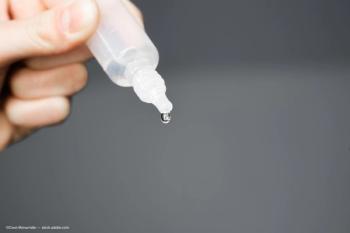
Latest tonometry devices all have their pluses and minuses
Yvonne Buys, MD, says ophthalmologists can choose from a range of the latest devices for measuring IOP, each with its own strengths and weaknesses. While new technology continues to emerge, Dr. Buys provides an overview of tonometer technology.
By Laird Harrison;Reviewed by Yvonne Buys, MD
Ophthalmologists can choose from a range of the latest devices for measuring intraocular pressure (IOP), each with its own strengths and weaknesses, according to Yvonne Buys, MD.
While new technology continues to emerge, nothing has yet to replace the Goldmann applanation tonometer, said Dr. Buys, who gave an overview of tonometer technology. Dr. Buys is professor, Department of Ophthalmology and Vision Sciences, University of Toronto, Canada.
"The Goldmann remains the gold standard," Dr. Buys told Ophthalmology Times. "But you need to have another device to measure IOP when you can't use the Goldmann."
Multiple limitations have spurred researchers to develop alternatives. Variations in the cornea–such as corneal thickness, curvature, elasticity or rigidity, and hydration–can influence Goldmann readings.
Limitations of Goldmann
The Goldmann tonometry also cannot accommodate patients unable to sit at a slit lamp because they are bedridden, in wheelchairs, have severe neck problems, or certain body types. In addition, the Goldmann requires sterilization and calibration.
Because patients must visit their practitioners for Goldmann tonometry, it only provides IOP at a single point in time, typically during normal office hours.
"It only allows you to get a snapshot measurement,” said Dr. Buys. “We do know that eye pressure varies throughout the day. With tonometry, it is also important to know the range of variability and specifically how high it's going."
Since the advent of the Goldmann tonometer in 1954, at least nine other approaches have emerged, seven of them in the past 15 years, said Dr. Buys.
Released in 2003, the Pascal Dynamic Contour Tonometer works by the principle of contour matching rather than applanation. This eliminates the influence of corneal thickness, rigidity, curvature, and elastic properties. It is not a variable-force tonometer, and it provides the ocular pulse amplitude.
On the other hand, it takes a mean of 6 seconds to obtain a reading. "In a busy clinic this can be a limitation," added Dr. Buys.
Non-contact tonometers
Bi-direction, non-contact air pump tonometers include the Reichert ORA and the Oculus Corvis STL. Both measure Goldmann-correlated IOP (IOPg) and corneal-compensated IOP (IOPcc). The Oculus also provides a video of the corneal deformation and offers 10 measurements of corneal properties.
The Reichert ORA measures corneal resistance factor (the viscoelastic properties of the cornea) and corneal hysteresis (the ability of the cornea to absorb and dissipate energy)–the latter of which has been reported to be an independent risk factor for both the development and progression of glaucoma.
The Diaton is a transpalpebral, transscleral tonometer that may have had use in patients with keratoprostheses, a challenge none of the other devices have surmounted.
"Unfortunately, it's more like a random number generator because its values are really not comparable to Goldmann tonometry," said Dr. Buys.
The Icare Rebound tonometer directs a disposable magnetized probe to the cornea. It converts the deceleration time of this contact to IOP.
Because it is fast, it doesn't require anesthesia, but for the same reason, it is influenced by short-term variations in pressure, so a mean of about six measurements are needed for a final reading.
At-home device
The Icare HOME, a hand-held device, can be used by the patient at home, so it is not limited to office hours. It also doesn't require anesthesia.
It recognizes the difference between the left and right eyes, and it stores its results for viewing on a personal computer. However, it cannot be used lying down.
About 75% to 100% of patients were able to use the Icare Home successfully in various studies. Industry standards call for a variation from Goldmann readings of ± 5 mm Hg.
When patients, who were excluded from correlations studies, were added, about 50%-100% of readings fell within that margin. The Icare Home tends to underestimate at lower pressures and overestimate at higher pressures, said Dr. Buys.
Triggerfish lens
The Sensimed Triggerfish is a soft disposable silicone contact lens embedding a micro-sensor that captures spontaneous circumferential changes at the corneoscleral area. These changes are presumed to be influenced by IOP, but the manufacturer assumes the changes are linear.
"I can't imagine the corneal curvature change is the same when you go from 7 mm Hg to 8 mm Hg as it is from 59 mm Hg to 60 mm Hg," said Dr. Buys.
The Triggerfish does offer a robust number of measurements, and its software cleans up erroneous values, she said.
In their own research, Dr. Buys and colleagues found that readings with the Triggerfish tend to drift upward over time, and other researchers have corroborated this finding.
It is not clear whether this is some statistical artifact, whether the tight-fitting Triggerfish contact lens is affecting pressure, or whether this is an actual phenomenon. However, Dr. Buys and colleagues did not find a similar increase in pressure when comparing measurements with the Goldmann immediately before and after using the Triggerfish.
Another limitation of the Triggerfish is that it measures in arbitrary units rather than mm Hg, the standard unit of measure for eye pressure, said Dr. Buys.
Challenges with new devices
In general, poor correlations with Goldmann values has posed a challenge with the newer devices, she said–with the Pascal overestimating; the Reichert, Corvis, and Icare over- and under-estimating; and the Diaton correlating so poorly that no comparison can be made.
For this reason, Dr. Buys recommended against changing techniques while following an individual patient.
Dr. Buys concluded that while the Goldmann remains the gold standard, all these devices can indicate high pressures, and each has some advantages that might make it worthwhile for a particular patient. This highlights the importance of an individualized approach to tonometry.
Yvonne Buys, MD.
This article was adapted from a presentation that Dr. Buys delivered at the Glaucoma Subspecialty Day held prior to the 2017 American Academy of Ophthalmology meeting. Dr. Buys receives grant support from Sensimed.
Newsletter
Don’t miss out—get Ophthalmology Times updates on the latest clinical advancements and expert interviews, straight to your inbox.













































